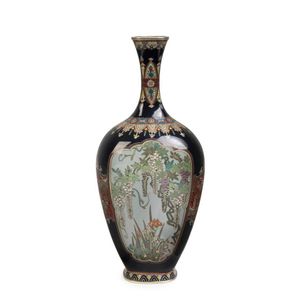
Japanese Meiji Period Wire Work Cloisonne Vase, Floral Motif
A fine antique Japanese silver and gold wire work cloisonne vase with floral motif, possibly the work of Namikawa Yasuyuki, Meiji period, 19th/20th century, 15 cm high

Rare Meiji Cloisonne Enamel Vesta Case by Namikawa Yasayuki
Rare Japanese Meiji period cloisonne enamel vesta case, by Namikawa Yasayuki, signed Kyoto Namikawa under cover), of elliptical form, decorated with foliate frieze on a turquoise ground, between stylised black and green floral borders, with gilt hinged…

Meiji cloisonne vase with nesting birds and flowering tree
A late Meiji period cloisonne vase in the manner of Namikawa Sosuke, ovoid form raised from a circular foot decorated with nesting birds in a flowering tree upon a grey trianon ground, 38 cm height

Japanese Cloisonne Vase with Enamel Butterflies & Flowers
A Japanese cloisonne vase, possibly Namikawa Yasuyuki, Meiji period (1868-1912), with high quality enamel decoration in six alternately coloured sections with scrolling grasses, flowers and various butterflies in flight. The neck and shoulder featuring…

Meiji period cloisonne panel by Namikawa Sosuke
Fine Japanese Meiji period cloisonne panel, attributed to Namikawa Sosuke (1847-1910), of rectangular form, beautifully depicting a cascading waterfall through maple tree foliage and a grey shadowed background, in the shosen technique, 53 cm x 26 cm

Meiji Japanese Cloisonne Box with Crane and Floral Motifs
A Japanese cloisonne box, Meiji period, of compressed globular form, decorated with cranes and flowers within a landscape, the base with stylized textile motifs, all against a blue ground. In the style of Namakawa Yasuyuki, 4 cm high, 9.25 cm diameter, a…

Japanese Cloisonne Wisteria Vase by Namikawa Yasuyuki
A fine Japanese Namikawa Yasuyuki cloisonne vase depicting wisteria upon a black ground. Silver rim & base plate. Signed via inscribing onto the base plate 'Kyoto Yasuyuki' height 9.5 cm

Japanese Cloisonne Butterfly Vase, Meiji Period
A small Japanese cloisonne vase in the manner of Yasuyuki Namikawa, Meiji period, squat ovoid shape. Decorated with three butterflies on a midnight blue ground, finely patterned to the foot and shoulder, the mouth with a square fret border. Height 7.4 cm.…

Midnight Blue Wisteria Cloisonne Vase, Meiji Period
A small Japanese cloisonne vase in the manner of Yasuyuki Namikawa, Meiji period, ovoid shape. Decorated with trailing tendrils and racemes of wisteria on a midnight blue ground, finely patterned to the foot and shoulder, the mouth with a square fret…

Dark Green Cloisonne Vase with Water Bird and Orchids
Hexagonal dark green cloisonne vase possibly Namikawa Yasuyuki decorated with water bird hidden amongst orchids on a green background, height 19 cm

Namikawa Yasuyuki Cloisonne Hexagonal Vase with Maple and Cranes
Good cloisonne hexagonal vase signed possibly Namikawa Yasuyuki decorated with maple tree and cranes on a light green background, height 16 cm

Meiji Period Cloisonne Jar with Bird and Flowers
A fine Japanese cloisonne small jar, Meiji period (1868-1912), exquisitely decorated with a bird over exotic flowers, the soft enamels within gold wires on a blue ground, with a band of silver mounted at the rim, signed 'Namikawa Yasayuki' on a silver…

Japanese Enamel and Silver Covered Box by Namikawa Sosuke
Namikawa Sosuke workshop (1847-1919), Japanese bronze, silver and enamel covered box the cover with an enamel panel of two carp and a turtle swimming above water plants designed in wireless cloisonne, with silver interior, signed with the seal of Namikawa…
 Loading more...
Loading more...